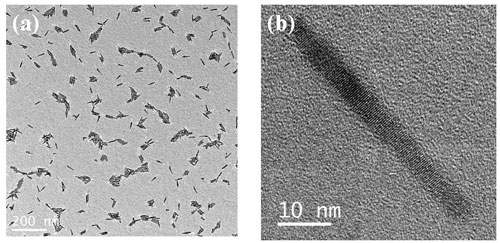| Posted: Mar 29, 2011 | |
Simple route to semiconductor anisotropic organic-inorganic nanocomposites for solar cells |
|
| (Nanowerk Spotlight) Over the past few years, research into fabrication techniques for nanocrystals has led to rod-like structures (nanorods) with diameters that range from 2 to 10 nm and lengths ranging from 5 to 100 nm. Due to their intrinsic structural anisotropy, nanorods possess many unique properties that make them potentially better nanocrystals than quantum dots for photovoltaics and biomedical applications. | |
| The power conversion efficiency of solar cells made of conjugated polymer/nanorod nanocomposites can be maximized when the nanocomposites are aligned perpendicularly between two electrodes for effective exciton dissociation and transport. To realize this, external fields can be applied to induce the self-assembly/alignment. The challenge is how to assemble them over a large scale – current self-assembly studies of cadmium selenide (CdSe) nanorods in literature are limited to only a micrometer scale. New design approaches are therefore needed to solve this problem. | |
| "Photovoltaic devices made of nanorods and conjugated polymers show an improved optical absorption in the red and near-infrared ranges originating from the nanorods," Zhiqun Lin, an associate professor in the Department of Materials Science and Engineering at Iowa State University, explains to Nanowerk. "The long axis of nanorods provides a continuous pathway for charge transport, an advantage over quantum dots where electron hopping between quantum dots is required. As such, we were motivated to synthesize semiconductor anisotropic organic-inorganic nanocomposite materials." | |
| To date, conjugated polymer/nanocrystal composites are widely prepared by physically mixing conjugated polymers and nanocrystals. Lin points out that it remains challenging to control the detailed morphology and dispersion of nanocrystals within conjugated polymers at the nanoscale. | |
| "The nanocrystals are often passivated with insulating organic ligands that hinder the efficient electronic interaction (e.g., charge transfer) with the surrounding conjugated polymers. Moreover, due to the large difference in their solubility, phase separation of conjugated polymers and nanocrystals was inevitable, thus reducing the interfacial area between them and limiting the performance of the resulting photovoltaic devices." | |
| To this end, the ability to chemically tether nanocrystals with conjugated polymers – i.e., preparing conjugated polymer-nanocrystal nanocomposites with well-controlled interfaces – provides a means of achieving a uniform dispersion of nanocrystals and, most importantly, significantly promoting the electronic interaction between the electron-donating conjugated polymers and electron-accepting nanocrystals. Notably, this strategy has only recently been developed and primarily implemented via ligand exchange that suffers from incomplete surface coverage. | |
| In contrast, a novel approach developed by Lin's group is simple yet robust, leading to greatly increased grafting density. The resulting anisotropic nanocomposites, in which P3HT and CdSe nanorods are intimately contacted, may be very promising for use in organic/inorganic hybrid solar cells with improved power conversion efficiency due to 1) an increased interfacial contact between conjugated polymers and one-dimensional nanorods, and 2) continuous pathways provided by the long axis of nanorods. | |
 |
|
| TEM images of (a) BBPA-functionalized CdSe nanorods, and (b) close-up of an individual nanorod. (Reprinted with permission from Wiley-VCH Verlag) | |
| The team has reported their findings in the March 25, 2011 online edition of Angewandte Chemie International Edition ("Semiconductor Anisotropic Nanocomposites Obtained by Directly Coupling Conjugated Polymers with Quantum Rods"). | |
| The nanocomposites described in this paper possess a well-defined interface between P3HT and CdSe nanorods, thereby promoting the effective dispersion of CdSe nanorods within nanocomposites and facilitating the electronic interaction between P3HT and CdSe nanorods. It successfully solved both microscopic phase separation and hindered charge transfer problems that widely existed in the organic/inorganic hybrid solar cells. | |
| "We designed a new ligand, bromobenzylphosphonic acid (BBPA), which not only works as a ligand to allow for the growth of elongated CdSe nanorods, but also provides a functional group – i.e., azide after converting aryl bromide end group on BBPA – that can undergo a click reaction with ethynyl-terminated P3HT" says Lin. "Notably, this newly developed catalyst-free azide?alkyne cycloaddition carries many advantages over Heck coupling to prepare P3HT-CdSe nanorod nanocomposite, including good selectivity, nearly complete conversion, and generally no need for purification." | |
| Lin also notes that this synthetic strategy can be easily extended to other various elongated nanostructures (e.g., nanowire, tetrapods, etc.) as well as other types of semiconductors (e.g., CdS, CdTe, PbS, PbSe, etc.) for use in solar cells. | |
| "In addition" says Lin, "compared to the nanorod morphology, tetrapods and hyperbranched structures may be even more promising to realize high efficiency solar cells as no self-assembly process is needed due to their intrinsic 3-dimentional structures. This is the subject of current studies in our lab." | |
 By
Michael
Berger
– Michael is author of three books by the Royal Society of Chemistry:
Nano-Society: Pushing the Boundaries of Technology,
Nanotechnology: The Future is Tiny, and
Nanoengineering: The Skills and Tools Making Technology Invisible
Copyright ©
Nanowerk LLC
By
Michael
Berger
– Michael is author of three books by the Royal Society of Chemistry:
Nano-Society: Pushing the Boundaries of Technology,
Nanotechnology: The Future is Tiny, and
Nanoengineering: The Skills and Tools Making Technology Invisible
Copyright ©
Nanowerk LLC
|
|
|
Become a Spotlight guest author! Join our large and growing group of guest contributors. Have you just published a scientific paper or have other exciting developments to share with the nanotechnology community? Here is how to publish on nanowerk.com. |
|
